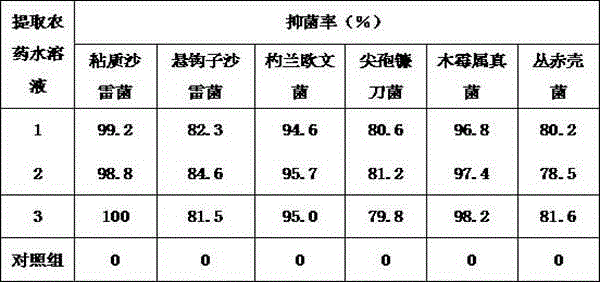Pesticide for preventing and treating corm rottenness pathogen of saffron crocus as well as preparation and using methods of pesticide
A technology for bulb decay and saffron, which is applied in the directions of botanical equipment and methods, chemicals for biological control, horticultural methods, etc., can solve problems such as decreased control effect, environmental harm, ecological environment damage, etc., and achieves improved control effect, The effect of reducing pollution and high safety
- Summary
- Abstract
- Description
- Claims
- Application Information
AI Technical Summary
Problems solved by technology
Method used
Image
Examples
Embodiment 1
[0022] A pesticide for preventing and treating saffron bulb rot, which is prepared from the following raw medicinal materials in parts by weight: 10 parts of Sophora flavescens, 20 parts of Huanan Yunshi, and 20 parts of Western Ivy.
[0023] The preparation method of the pesticide used for saffron bulb rot, the specific preparation steps are as follows: (1) dry Sophora flavescens, South China yunshi and foreign ivy, cut into granules, and pass through a 60-mesh sieve; (2) According to the ratio of material to liquid 1: Add ethanol with a volume fraction of 95% at 6g / ml and mix well; (3) Reflux the mixture twice at 80°C, and combine the filtrate to obtain the extract; (4) Add additives and water to the extract for dilution An aqueous solution with a concentration of 500 ppm is obtained, wherein the additives are antifreeze and dispersant.
Embodiment 2
[0025] A pesticide used for preventing and treating saffron bulb rot is prepared from the following raw medicinal materials in parts by weight: 20 parts of Sophora flavescens, 20 parts of Huanan Yunshi, and 20 parts of Western ivy.
[0026] The preparation method of the pesticide used for saffron bulb rot is characterized in that the specific preparation steps are as follows: (1) Dried Sophora flavescens, South China Yunshi and Ivy, cut into granules, and pass through a 60-mesh sieve; (2) According to the solid-liquid ratio of 1:8g / ml, add ethanol with a volume fraction of 95% and mix well; (3) Reflux the mixture twice at 80°C, and combine the filtrate to obtain the extract; (4) Add additives to the extract Dilute with water to obtain a concentration of 500ppm aqueous solution, wherein the additives are antifreeze, emulsifier and dispersant.
[0027] Wherein, the antifreeze agent is at least one of glycerin, propylene glycol, ethylene glycol, sodium chloride, calcium chloride,...
Embodiment 3
[0031] Embodiment 3: laboratory antibacterial test
[0032] The present embodiment adopts indoor tube-and-dish method to respectively measure the effect of extracting pesticide aqueous solution on saffron bulb rot disease pathogenic bacteria (Serratia marcescens, Serratia rubus, Cypripedium Erwinia) and fungi (Fusarium oxysporum, Trichoderma fungus) , Plexus erythrosum) antibacterial rate.
[0033] (1) Bacteriostasis experiment on pathogenic bacteria of saffron bulb rot
[0034] Prepare potato dextrose agar medium (PDA medium: potato 200g, glucose 20g, agar 18g, water 1000mL, natural pH, 121°C, high-pressure steam sterilization) on the ultra-clean workbench, and then add the concentration before the PDA medium solidifies Extract the pesticide aqueous solution at 500ppm and mix it evenly; after activating the strains of Serratia marcescens, Serratia rubella, and Erwinia cypriphytum respectively, pick an appropriate amount of single colony cells and prepare them with sterile ph...
PUM
 Login to View More
Login to View More Abstract
Description
Claims
Application Information
 Login to View More
Login to View More - Generate Ideas
- Intellectual Property
- Life Sciences
- Materials
- Tech Scout
- Unparalleled Data Quality
- Higher Quality Content
- 60% Fewer Hallucinations
Browse by: Latest US Patents, China's latest patents, Technical Efficacy Thesaurus, Application Domain, Technology Topic, Popular Technical Reports.
© 2025 PatSnap. All rights reserved.Legal|Privacy policy|Modern Slavery Act Transparency Statement|Sitemap|About US| Contact US: help@patsnap.com

